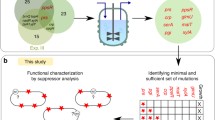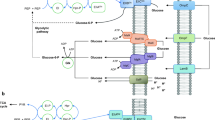Abstract
The chb operon of Escherichia coli is involved in the utilization of chitooligosaccharides. While acquisition of two classes of mutations leading to altered regulation of the chb operon is necessary to confer the ability to utilize the glucose disaccharide cellobiose to wild-type strains of E. coli, in the closely related organism Shigella sonnei, Cel+ mutants arise relatively faster, requiring only a single mutational event. In Type I mutants, the insertion of IS600 at −21 leads to ChbR regulator-independent, constitutive expression of the operon. In Type II mutants, the insertion of IS2/600 within the distal binding site of the negative regulator NagC leads to ChbR-dependent cellobiose-inducible expression of the operon. These studies underscore the significance of strain background, specifically the diversity of transposable elements, in the evolution of novel metabolic functions. Constitutive expression of the chb operon also enables utilization of the aromatic β-glucosides arbutin and salicin, implying that the chb structural genes are inherently promiscuous.





Similar content being viewed by others
References
Datsenko KA, Wanner BL (2000) One-step inactivation of chromosomal genes in Escherichia coli K-12 using PCR products. Proc Natl Acad Sci USA 97:6640–6645
Desai SK, Nandimath K, Mahadevan S (2010) Diverse pathways for salicin utilization in Shigella sonnei and Escherichia coli carrying an impaired bgl operon. Arch Microbiol 192:821–833
Kachroo AH, Kancherla AK, Singh NS, Varshney U, Mahadevan S (2007) Mutations that alter the regulation of the chb operon of Escherichia coli allow utilization of cellobiose. Mol Microbiol 66:1382–1395
Keyhani NO, Roseman S (1997) Wild-type Escherichia coli grows on the chitin disaccharide, N, N′-diacetylchitobiose, by expressing the cel operon. Proc Natl Acad Sci USA 94:14367–14371
Keyhani NO, Bacia K, Roseman S (2000a) The transport/phosphorylation of N, N′-diacetylchitobiose in Escherichia coli. Characterization of phospho-IIB(Chb) and of a potential transition state analogue in the phosphotransfer reaction between the proteins IIA(Chb) AND IIB(Chb). J Biol Chem 275:33102–33109
Keyhani NO, Boudker O, Roseman S (2000b) Isolation and characterization of IIAChb, a soluble protein of the enzyme II complex required for the transport/phosphorylation of N, N′-diacetylchitobiose in Escherichia coli. J Biol Chem 275:33091–33101
Keyhani NO, Wang LX, Lee YC, Roseman S (2000c) The chitin disaccharide, N, N′-diacetylchitobiose, is catabolized by Escherichia coli and is transported/phosphorylated by the phosphoenolpyruvate:glycose phosphotransferase system. J Biol Chem 275:33084–33090
Kharat AS, Mahadevan S (2000) Analysis of the beta-glucoside utilization (bgl) genes of Shigella sonnei: evolutionary implications for their maintenance in a cryptic state. Microbiology 146(Pt 8):2039–2049
Kricker M, Hall BG (1984) Directed evolution of cellobiose utilization in Escherichia coli K12. Mol Biol Evol 1:171–182
Lan R, Reeves PR (2002) Escherichia coli in disguise: molecular origins of Shigella. Microbes Infect 4:1125–1132
Miller JH (1972) Experiments in molecular genetics. Cold Spring Harbor Laboratory Press, Cold Spring Harbor
Parker LL, Hall BG (1990a) Mechanisms of activation of the cryptic cel operon of Escherichia coli K12. Genetics 124:473–482
Parker LL, Hall BG (1990b) Characterization and nucleotide sequence of the cryptic cel operon of Escherichia coli K12. Genetics 124:455–471
Patrick WM, Quandt EM, Swartzlander DB, Matsumura I (2007) Multicopy suppression underpins metabolic evolvability. Mol Biol Evol 24:2716–2722
Peng J, Yang J, Jin Q (2009) The molecular evolutionary history of Shigella spp. and enteroinvasive Escherichia coli. Infect Genet Evol 9:147–152
Plumbridge J, Pellegrini O (2004) Expression of the chitobiose operon of Escherichia coli is regulated by three transcription factors: NagC, ChbR and CAP. Mol Microbiol 52:437–449
Pupo GM, Lan R, Reeves PR (2000) Multiple independent origins of Shigella clones of Escherichia coli and convergent evolution of many of their characteristics. Proc Natl Acad Sci USA 97:10567–10572
Schmittgen TD, Livak KJ (2008) Analyzing real-time PCR data by the comparative C(T) method. Nat Protoc 3:1101–1108
Shepherd JG, Wang L, Reeves PR (2000) Comparison of O-antigen gene clusters of Escherichia coli (Shigella) sonnei and Plesiomonas shigelloides O17: sonnei gained its current plasmid-borne O-antigen genes from P. shigelloides in a recent event. Infect Immun 68:6056–6061
Singh J, Mukerji M, Mahadevan S (1995) Transcriptional activation of the Escherichia coli bgl operon: negative regulation by DNA structural elements near the promoter. Mol Microbiol 17:1085–1092
Singh NS, Das G, Seshadri A, Sangeetha R, Varshney U (2005) Evidence for a role of initiation factor 3 in recycling of ribosomal complexes stalled on mRNAs in Escherichia coli. Nucl Acids Res 33:5591–5601
Thompson J, Ruvinov SB, Freedberg DI, Hall BG (1999) Cellobiose-6-phosphate hydrolase (CelF) of Escherichia coli: characterization and assignment to the unusual family 4 of glycosylhydrolases. J Bacteriol 181:7339–7345
Verma SC, Mahadevan S (2012) The chbG gene of the chitobiose (chb) operon of Escherichia coli encodes a chitooligosaccharide deacetylase. J Bacteriol 194:4959–4971
Woodcock DM et al (1989) Quantitative evaluation of Escherichia coli host strains for tolerance to cytosine methylation in plasmid and phage recombinants. Nucl Acids Res 17:3469–3478
Wright BE (2004) Stress-directed adaptive mutations and evolution. Mol Microbiol 52:643–650
Yang F et al (2005) Genome dynamics and diversity of Shigella species, the etiologic agents of bacillary dysentery. Nucl Acids Res 33:6445–6458
Zangoui P, Vashishtha K, Mahadevan S (2015) Evolution of aromatic beta-glucoside utilization by successive mutational steps in Escherichia coli. J Bacteriol 197:710–716
Acknowledgments
This work was supported by an institutional grant from the Department of Biotechnology (DBT), Govt. of India, to the Indian Institute of Science and infrastructural support from the Department of Science and Technology (DST) under the FIST Program and the Universities Grants Commission (UGC), Govt. of India. AMJ thanks the Council for Scientific and Industrial Research (CSIR), Govt. of India, for a senior research fellowship.
Author information
Authors and Affiliations
Corresponding author
Additional information
Communicated by Erko Stackebrandt.
Electronic supplementary material
Below is the link to the electronic supplementary material.
Rights and permissions
About this article
Cite this article
Joseph, A.M., Sonowal, R. & Mahadevan, S. A comparative study of the evolution of cellobiose utilization in Escherichia coli and Shigella sonnei . Arch Microbiol 199, 247–257 (2017). https://doi.org/10.1007/s00203-016-1299-0
Received:
Revised:
Accepted:
Published:
Issue Date:
DOI: https://doi.org/10.1007/s00203-016-1299-0




